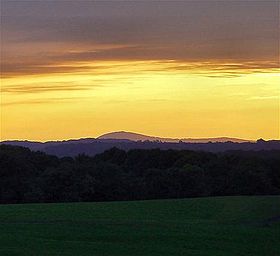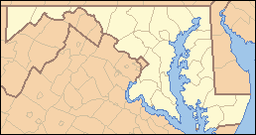Sugarloaf Mountain (Maryland)
| Sugarloaf Mountain | |
|---|---|

Sugarloaf Mountain, sunset
|
|
| Highest point | |
| Elevation | 1,282 ft (391 m) |
| Geography | |
| Location | Frederick County, Maryland |
| Parent range | Blue Ridge Mountains (outlier) |
| Geology | |
| Age of rock | approx. 500 million years |
| Mountain type | Monadnock |
| Climbing | |
| Easiest route |
Stairway and trail to summit |
| Designated | June 1969 |
| Sugarloaf Mountain, Maryland | |
| National Natural Landmark | |
|
Sugarloaf Mountain, Maryland
|
|
| Country | United States |
|---|---|
| State | Maryland |
| Coordinates | 39°16′9.15″N 77°23′42.89″W / 39.2692083°N 77.3952472°WCoordinates: 39°16′9.15″N 77°23′42.89″W / 39.2692083°N 77.3952472°W |
| Established | June 1969 |
| Owner | Private owner |
| IUCN category | ? |
| Nearest city | Barnesville, Maryland |
| Website: Stronghold, Inc. Sugarloaf Mountain | |
Stairway and trail to summit
Sugarloaf Mountain is a small (1,282 foot; 391 m) mountain and park about 10 miles (16 km) south of Frederick, Maryland, USA. The closest village is Barnesville, located just over one mile from the foot of the mountain. The peak of this relatively low mountain is approximately 800 feet (244 m) higher than the surrounding farmland. It is visible from many parts of northern Montgomery County and southern Frederick County, notably from I-270 north of the town of Germantown. Because of its geological and natural history interest, it was designated a National Natural Landmark in 1969. It is a notable example of an admission-free, privately owned scenic park.
During the Maryland Campaign of the American Civil War in 1862, Union forces occupying the summit, which was being used as an observation and signal station, first spotted the Army of Northern Virginia on September 5 as it crossed the Potomac River into Maryland. The following morning as the small Union force on the mountain began to retreat in the face of the oncoming Confederate Army, they ran into the unsuspecting 1st North Carolina Infantry and a small skirmish ensued. The Union force was able to escape, but it was later caught by Confederate cavalry at Urbana.
In the early 20th century Chicago businessman Gordon Strong bought substantial land holdings on and around the mountain. In 1925, the architect Frank Lloyd Wright, on commission from Strong, proposed an automobile objective development for the top of the mountain, but that was never carried out.
...
Wikipedia


